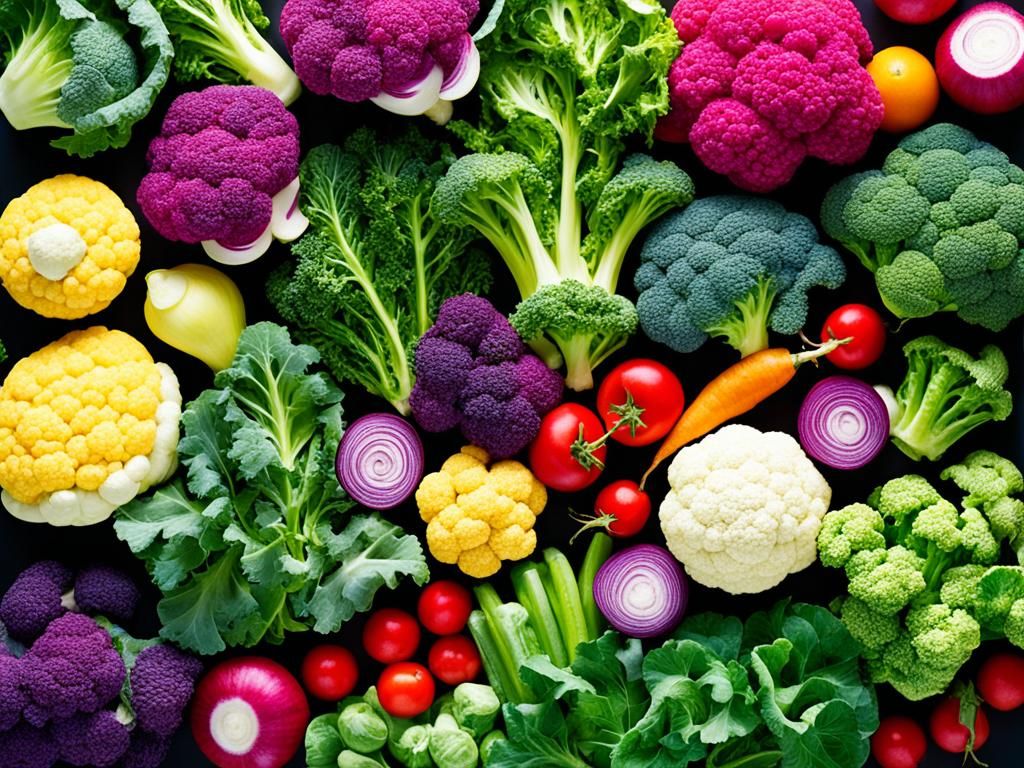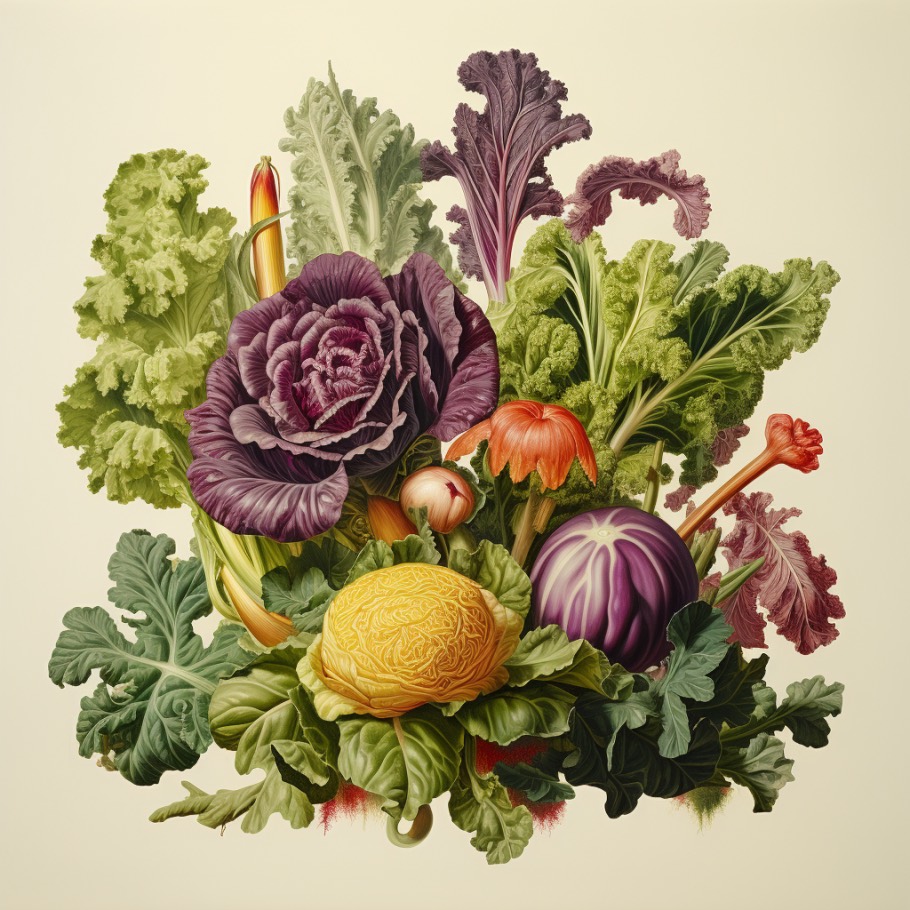
Everything You Need to Know About Cruciferous Veggies
Everything you need to know about cruciferous veggies starts with understanding their unique place in the plant kingdom. These vegetables, known for their distinctive flavor and health benefits, belong to the Brassicaceae family. From the humble broccoli to the vibrant kale, these cruciferous vegetables have been a part of human diets for centuries, their history and origins tracing back to ancient civilizations.
Cruciferous vegetables are nutritional powerhouses, packed with vitamins, minerals, and antioxidants. They are particularly known for their high levels of glucosinolates, compounds that have been linked to a variety of health benefits, including reducing cancer risk, improving heart health, and boosting immunity.
This makes them a valuable addition to any diet, offering a unique flavor profile that can be incorporated into a wide range of dishes.
Introduction to Cruciferous Vegetables
Cruciferous vegetables, also known as cole crops, are a diverse group of plants that belong to the Brassicaceae family. They are characterized by their distinctive cruciform flowers, which resemble a cross. These vegetables are a staple in many cuisines worldwide, valued for their nutritional benefits and unique flavors.
Botanical Classification
Cruciferous vegetables belong to the Brassicaceae family, which encompasses over 3,700 species. This family is further divided into several genera, including Brassica, Raphanus, and Armoracia. The name “cruciferous” derives from the Latin word “crux,” meaning “cross,” which refers to the shape of their flowers.
These flowers typically have four petals arranged in a cross-like pattern.
Common Cruciferous Vegetables
Cruciferous vegetables are widely consumed around the globe and come in a variety of shapes, sizes, and colors. Here are some of the most common examples:
- Broccoli: This popular vegetable features dense clusters of green florets and a thick stalk. It is rich in vitamins, minerals, and antioxidants.
- Cauliflower: Cauliflower has a white, compact head composed of flower buds. It is a versatile vegetable that can be boiled, roasted, or steamed.
- Cabbage: Cabbage is a leafy green vegetable with tightly packed leaves that form a head. It is often used in salads, soups, and stews.
- Kale: Kale is a leafy green vegetable with crinkled leaves that can be eaten raw or cooked. It is known for its high nutritional content, particularly vitamin K.
- Brussel Sprouts: These small, round vegetables resemble miniature cabbages. They have a slightly bitter flavor and are often roasted or steamed.
- Kohlrabi: Kohlrabi is a bulbous vegetable with a mild, sweet flavor. It can be eaten raw or cooked and is often used in salads or stir-fries.
- Collard Greens: Collard greens are leafy green vegetables with large, dark green leaves. They are often cooked and served as a side dish.
- Bok Choy: Bok choy is a leafy green vegetable with a white stalk and dark green leaves. It is commonly used in Asian cuisine.
- Turnip: Turnips are root vegetables with a white, bulbous root and green leaves. They can be eaten raw or cooked and are often used in salads or stews.
- Radish: Radishes are root vegetables with a crisp texture and a spicy flavor. They are commonly eaten raw and are often used as a garnish.
- Arugula: Arugula is a leafy green vegetable with a peppery flavor. It is often used in salads and as a garnish.
History and Origin of Cruciferous Vegetables
Cruciferous vegetables have a long history of cultivation, dating back thousands of years. They are believed to have originated in the Mediterranean region and were widely grown in ancient civilizations. The cultivation of these vegetables spread throughout Europe and Asia, eventually reaching the Americas.
“Cruciferous vegetables have been a staple food source for centuries, providing essential nutrients and flavor to diverse cuisines.”
The cultivation of cruciferous vegetables has evolved over time, with farmers developing new varieties and improving their yields. Today, these vegetables are grown in many parts of the world, with China being the largest producer.
Nutritional Benefits of Cruciferous Vegetables
Cruciferous vegetables are nutritional powerhouses, packed with essential vitamins, minerals, and antioxidants. These vegetables are not only delicious but also contribute significantly to a healthy lifestyle. They offer a wide range of health benefits, from reducing the risk of chronic diseases to boosting your immune system.
Vitamins, Minerals, and Antioxidants
Cruciferous vegetables are excellent sources of various essential nutrients.
- Vitamin C: This vitamin is crucial for immune function, collagen production, and wound healing. Broccoli, Brussels sprouts, and cauliflower are particularly rich in vitamin C.
- Vitamin K: Important for blood clotting and bone health, vitamin K is abundant in kale, collard greens, and cabbage.
- Folate: Crucial for cell division and growth, folate is found in high amounts in broccoli, Brussels sprouts, and cauliflower.
- Fiber: Cruciferous vegetables are high in dietary fiber, which aids digestion, regulates blood sugar levels, and promotes satiety.
- Potassium: This mineral plays a role in maintaining blood pressure, muscle function, and nerve transmission. Kale, collard greens, and broccoli are good sources of potassium.
- Antioxidants: Cruciferous vegetables are rich in antioxidants, such as sulforaphane and vitamin C, which protect cells from damage caused by free radicals. These antioxidants may help reduce the risk of chronic diseases.
Health Benefits of Cruciferous Vegetables
The nutritional richness of cruciferous vegetables translates into numerous health benefits.
- Cancer Prevention: Studies have shown that regular consumption of cruciferous vegetables may reduce the risk of certain cancers, including lung, colorectal, and breast cancer. The glucosinolates in these vegetables break down into compounds that may inhibit cancer cell growth.
- Heart Health: Cruciferous vegetables are low in calories and fat, and they are rich in fiber, which can help lower cholesterol levels. They also contain potassium, which is essential for maintaining healthy blood pressure. These factors contribute to a reduced risk of heart disease.
- Improved Digestion: The high fiber content in cruciferous vegetables promotes healthy digestion by adding bulk to stool, aiding in regular bowel movements, and preventing constipation.
- Boosted Immunity: Vitamin C, a key nutrient found in cruciferous vegetables, plays a vital role in strengthening the immune system, helping the body fight off infections and diseases.
Glucosinolates: A Unique Compound
Glucosinolates are sulfur-containing compounds found in cruciferous vegetables. When these vegetables are chopped, crushed, or chewed, the glucosinolates are converted into compounds with various health benefits.
These compounds have been shown to have anti-inflammatory, antioxidant, and anticancer properties.
Glucosinolates may also help protect against heart disease, diabetes, and other chronic conditions.
Culinary Uses of Cruciferous Vegetables
Cruciferous vegetables are incredibly versatile in the kitchen, offering a wide range of culinary possibilities. Their distinct flavors, textures, and nutritional profiles make them a valuable addition to any meal.
Ways to Enjoy Cruciferous Vegetables
Cruciferous vegetables can be enjoyed in various ways, from simple preparations to more elaborate dishes. Here’s a table showcasing common culinary uses, cooking methods, flavor profiles, and potential pairings for some popular cruciferous vegetables:| Vegetable | Common Culinary Uses | Cooking Methods | Flavor Profile | Potential Pairings ||—|—|—|—|—|| Broccoli | Steamed, roasted, sautéed, grilled, added to soups, stir-fries, salads | Steaming, roasting, sautéing, grilling | Earthy, slightly sweet, with a hint of bitterness | Garlic, ginger, lemon, cheese, nuts || Cauliflower | Roasted, mashed, pureed, used in cauliflower rice, added to soups, stews, curries | Roasting, mashing, pureeing, steaming | Mild, nutty, slightly sweet | Turmeric, cumin, coriander, garlic, lemon || Brussels Sprouts | Roasted, sautéed, braised, added to salads | Roasting, sautéing, braising | Nutty, slightly bitter, with a sweet undertone | Bacon, chestnuts, balsamic vinegar, lemon || Cabbage | Used in coleslaw, sauerkraut, kimchi, braised, stir-fried, added to soups, stews | Braising, stir-frying, pickling | Sweet, slightly bitter, with a pungent aroma | Apples, carrots, ginger, garlic, soy sauce || Kale | Sautéed, steamed, added to salads, smoothies, chips | Sautéing, steaming, blending | Earthy, slightly bitter, with a peppery note | Lemon, garlic, olive oil, nuts, seeds || Kohlrabi | Roasted, sautéed, pickled, added to salads | Roasting, sautéing, pickling | Mild, sweet, with a hint of nuttiness | Carrots, apples, lemon, dill, parsley || Bok Choy | Stir-fried, steamed, added to soups, stews | Stir-frying, steaming | Mild, sweet, with a slightly peppery note | Ginger, garlic, soy sauce, sesame oil, mushrooms || Radishes | Eaten raw, pickled, added to salads, sandwiches | Raw, pickled | Spicy, peppery, slightly sweet | Butter, cream cheese, vinegar, herbs || Turnips | Roasted, mashed, added to soups, stews | Roasting, mashing | Sweet, slightly earthy, with a mild peppery note | Carrots, onions, garlic, herbs |
Recipes Featuring Cruciferous Vegetables
Here are some recipe ideas showcasing the versatility of cruciferous vegetables:* Roasted Broccoli with Garlic and Parmesan:This classic dish combines the sweetness of broccoli with the savory flavors of garlic and Parmesan cheese.
Cauliflower Rice Stir-Fry A healthy and delicious alternative to traditional rice, cauliflower rice can be stir-fried with your favorite vegetables and protein.
Cruciferous veggies, like broccoli and kale, are packed with nutrients and can be incorporated into many dishes. But let’s be honest, sometimes the thought of chewing through a pile of raw broccoli can be a bit daunting. That’s where stretching comes in! Stretching your palate can help you appreciate new flavors, and learning to love new foods can be as simple as finding ways to learn to love stretching your taste buds.
So, next time you’re feeling adventurous, try roasting your broccoli with some garlic and olive oil, or blend kale into a smoothie. You might just surprise yourself!
Brussels Sprouts Salad with Bacon and Balsamic Vinaigrette This salad offers a delightful combination of sweet, savory, and tangy flavors.
Cabbage Soup with Apples and Ginger A comforting and flavorful soup perfect for a chilly day.
Kale and Sausage Pasta This pasta dish combines the earthy flavor of kale with the savory taste of sausage.
Kohlrabi Salad with Lemon and Dill A refreshing and flavorful salad that highlights the sweetness of kohlrabi.
Bok Choy and Mushroom Stir-Fry A quick and easy stir-fry that is packed with flavor and nutrients.
Radish and Butter Sandwich A simple and satisfying sandwich that showcases the spicy flavor of radishes.
Roasted Turnip and Carrot Mash A delicious and nutritious alternative to mashed potatoes.
Tips for Preparing and Cooking Cruciferous Vegetables
Choose fresh vegetables Select cruciferous vegetables that are firm, crisp, and free of blemishes.
Wash thoroughly Rinse vegetables under cold water to remove any dirt or debris.
Trim and chop Trim off any tough stems or leaves, and chop vegetables into bite-sized pieces.
Cook until tender-crisp Overcooking cruciferous vegetables can make them mushy and lose their flavor. Aim for tender-crisp texture.
Experiment with different cooking methods Roasting, sautéing, steaming, and grilling are all excellent ways to cook cruciferous vegetables.
Cruciferous veggies like broccoli, cauliflower, and Brussels sprouts are packed with nutrients and can be a great addition to any healthy diet. But if you’re tired of the same old roasted or steamed versions, you might be hitting a meal prep plateau.
Don’t worry, there are plenty of ways to shake things up! Check out these 6 proven ways to get out of a meal prep plateau and discover new and exciting ways to enjoy your cruciferous favorites. From flavorful stir-fries to creamy soups, the possibilities are endless!
Season generously Cruciferous vegetables pair well with a variety of herbs, spices, and seasonings.
Add acidity A squeeze of lemon juice or a splash of vinegar can enhance the flavor of cruciferous vegetables.
Enjoy in moderation
Cruciferous veggies like broccoli, cauliflower, and Brussels sprouts are packed with nutrients and antioxidants, but sometimes the same old recipes can get boring. To spice things up, why not try adding them to a fun new workout routine? Check out 8 fun ways to avoid home workout boredom for some creative ideas.
Once you’re energized and motivated, you can tackle those cruciferous veggies with renewed enthusiasm, knowing you’re doing something good for your body and mind!
Selecting and Storing Cruciferous Vegetables

Choosing the right cruciferous vegetables and storing them properly ensures you get the most out of their flavor and nutritional value. Here’s how to select and store these versatile vegetables for optimal freshness and quality.
Selecting Fresh Cruciferous Vegetables, Everything you need to know about cruciferous veggies
When selecting cruciferous vegetables at the market, look for signs of freshness and quality. Here’s what to keep in mind:
- Look for firm, vibrant vegetables:Avoid vegetables that are soft, wilted, or have discolored leaves.
- Choose vegetables with bright, even colors:Cruciferous vegetables should have vibrant colors that are consistent throughout.
- Inspect for damage:Check for any signs of bruising, cuts, or insect damage.
- Consider the size and shape:Choose vegetables that are appropriate for your intended use. For example, if you plan to roast broccoli, choose florets that are not too large.
Storing Cruciferous Vegetables
Proper storage is crucial for extending the shelf life of cruciferous vegetables and preserving their nutritional value.
- Refrigerate immediately:Once you bring your cruciferous vegetables home, refrigerate them as soon as possible.
- Store in airtight containers:Use airtight containers or plastic bags to prevent moisture loss and wilting.
- Avoid overcrowding:Ensure there is adequate space between vegetables to allow for proper air circulation.
- Store separately:Keep cruciferous vegetables away from ethylene-producing fruits and vegetables like apples and bananas, which can accelerate their ripening and decay.
Tips for Preventing Wilting and Preserving Nutritional Value
- Trim the stems:Before storing, trim the stems of cruciferous vegetables like broccoli and cauliflower. This helps prevent wilting and promotes freshness.
- Wash before storing:Washing cruciferous vegetables before storing can increase their shelf life. However, make sure to dry them thoroughly before storing to prevent spoilage.
- Avoid prolonged storage:While refrigeration can extend the shelf life of cruciferous vegetables, it’s best to consume them within a few days for optimal flavor and nutritional value.
Cruciferous Vegetables in Different Cultures

Cruciferous vegetables have a long and rich history in culinary traditions around the world. Their versatility and nutritional value have made them a staple ingredient in many cuisines, showcasing their adaptability to diverse cooking methods and cultural preferences.
Global Culinary Traditions
Cruciferous vegetables are deeply ingrained in the culinary traditions of many cultures, each with its unique ways of preparing and using these versatile vegetables.
- East Asia:In China, broccoli, bok choy, and Chinese cabbage are popular ingredients in stir-fries, soups, and dumplings. Japan features napa cabbage in dishes like ramen and kimuchi, while Korea incorporates kimchi, a fermented cabbage dish, as a staple side dish.
- Europe:Cauliflower, Brussels sprouts, and kale are prominent in European cuisine. Germany enjoys sauerkraut, a fermented cabbage dish, while Italy features broccoli rabe in pasta dishes and salads.
- Middle East:Cauliflower and broccoli are used in various Middle Eastern dishes, such as roasted vegetables, stews, and salads.
- South Asia:Cauliflower and broccoli are common ingredients in Indian cuisine, where they are used in curries, stir-fries, and vegetable dishes.
- North America:Cruciferous vegetables like broccoli, cauliflower, and cabbage are widely consumed in North America, often roasted, steamed, or incorporated into salads.
Cultural Significance
Cruciferous vegetables hold cultural significance in various societies, often representing specific traditions, celebrations, or values.
- Kimchi in Korea:Kimchi, a fermented cabbage dish, is a national treasure in Korea, symbolizing the country’s resilience and cultural identity.
- Sauerkraut in Germany:Sauerkraut, a fermented cabbage dish, is a traditional German food, often served during Oktoberfest and other festive occasions.
- Broccoli in China:Broccoli is considered a symbol of good fortune and prosperity in Chinese culture, often served during special celebrations and gatherings.
Regional Variations
The preparation methods and cultural significance of cruciferous vegetables vary widely across regions, reflecting the unique culinary traditions and preferences of each place.
- Chinese Stir-fries:Broccoli and bok choy are often stir-fried with garlic, ginger, and soy sauce in Chinese cuisine.
- Italian Pasta Dishes:Broccoli rabe is commonly used in Italian pasta dishes, often sautéed with garlic and olive oil.
- Indian Curries:Cauliflower and broccoli are frequently incorporated into Indian curries, adding a unique flavor and texture.
Examples of Cruciferous Vegetables in Different Culinary Traditions
| Culinary Tradition | Cruciferous Vegetable | Preparation Method |
|---|---|---|
| Chinese | Bok choy | Stir-fried with garlic, ginger, and soy sauce |
| Japanese | Napa cabbage | Used in ramen, kimuchi, and other dishes |
| Korean | Kimchi | Fermented cabbage dish |
| German | Sauerkraut | Fermented cabbage dish |
| Italian | Broccoli rabe | Sautéed with garlic and olive oil |
| Indian | Cauliflower | Used in curries, stir-fries, and vegetable dishes |
| North American | Broccoli | Roasted, steamed, or incorporated into salads |
Potential Health Concerns and Considerations

While cruciferous vegetables offer numerous health benefits, it’s important to be aware of potential health concerns associated with their consumption. These vegetables contain compounds that can interact with certain medications or health conditions, and excessive consumption might lead to digestive issues.
Goitrogens
Goitrogens are naturally occurring compounds found in cruciferous vegetables that can interfere with the thyroid gland’s ability to produce thyroid hormones. This is because goitrogens can inhibit the uptake of iodine, an essential element for thyroid hormone production.
Goitrogens are not a significant concern for most people, but individuals with thyroid conditions, such as hypothyroidism, should consult with their doctor about their cruciferous vegetable intake.
- Individuals with hypothyroidism:People with hypothyroidism, a condition where the thyroid gland doesn’t produce enough thyroid hormone, may need to limit their intake of cruciferous vegetables, as goitrogens can worsen their condition. Consulting with a healthcare professional is crucial to determine an appropriate intake level.
- Pregnant women:Pregnant women should be mindful of their cruciferous vegetable intake as goitrogens can potentially interfere with fetal thyroid development. A balanced diet that includes a variety of vegetables is generally recommended.
- Individuals taking thyroid medication:People taking thyroid medication should be cautious about their consumption of cruciferous vegetables, as goitrogens can interfere with the absorption and effectiveness of the medication. It’s essential to discuss this with their doctor and adjust their intake accordingly.
Digestive Issues
Cruciferous vegetables contain fiber and complex sugars that can cause digestive discomfort, such as gas, bloating, and diarrhea, in some individuals, especially when consumed in large quantities.
- Introducing cruciferous vegetables gradually:Start by incorporating small amounts of these vegetables into your diet and gradually increase your intake over time to allow your digestive system to adjust.
- Cooking methods:Cooking cruciferous vegetables can help break down some of the fiber and sugars, making them easier to digest.
- Choosing varieties:Some cruciferous vegetables, like broccoli and cauliflower, are generally considered easier to digest than others, like Brussels sprouts and cabbage.
Other Considerations
- Individuals with IBS:People with irritable bowel syndrome (IBS) may find that cruciferous vegetables trigger their symptoms. It’s advisable to consult with a healthcare professional for personalized dietary recommendations.
- Individuals with kidney stones:Some individuals with kidney stones may need to limit their intake of cruciferous vegetables, as they contain oxalate, a compound that can contribute to stone formation.
- Individuals with allergies:While rare, some individuals may be allergic to cruciferous vegetables, experiencing symptoms like skin rashes, hives, or digestive problems.
Conclusion: Everything You Need To Know About Cruciferous Veggies
So, whether you’re a seasoned chef or a beginner in the kitchen, incorporating cruciferous vegetables into your diet is a simple yet powerful way to enhance your health and enjoy delicious flavors. From their rich history and diverse culinary uses to their impressive nutritional benefits, these vegetables offer a world of possibilities for your taste buds and well-being.
So, get ready to explore the world of cruciferous vegetables and discover the many ways they can enrich your life.






